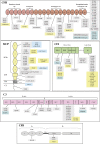Combined complement gene mutations in atypical hemolytic uremic syndrome influence clinical phenotype
- PMID: 23431077
- PMCID: PMC3582207
- DOI: 10.1681/ASN.2012090884
Combined complement gene mutations in atypical hemolytic uremic syndrome influence clinical phenotype
Abstract
Several abnormalities in complement genes reportedly contribute to atypical hemolytic uremic syndrome (aHUS), but incomplete penetrance suggests that additional factors are necessary for the disease to manifest. Here, we sought to describe genotype-phenotype correlations among patients with combined mutations, defined as mutations in more than one complement gene. We screened 795 patients with aHUS and identified single mutations in 41% and combined mutations in 3%. Only 8%-10% of patients with mutations in CFH, C3, or CFB had combined mutations, whereas approximately 25% of patients with mutations in MCP or CFI had combined mutations. The concomitant presence of CFH and MCP risk haplotypes significantly increased disease penetrance in combined mutated carriers, with 73% penetrance among carriers with two risk haplotypes compared with 36% penetrance among carriers with zero or one risk haplotype. Among patients with CFH or CFI mutations, the presence of mutations in other genes did not modify prognosis; in contrast, 50% of patients with combined MCP mutation developed end stage renal failure within 3 years from onset compared with 19% of patients with an isolated MCP mutation. Patients with combined mutations achieved remission with plasma treatment similar to patients with single mutations. Kidney transplant outcomes were worse, however, for patients with combined MCP mutation compared with an isolated MCP mutation. In summary, these data suggest that genotyping for the risk haplotypes in CFH and MCP may help predict the risk of developing aHUS in unaffected carriers of mutations. Furthermore, screening patients with aHUS for all known disease-associated genes may inform decisions about kidney transplantation.
Figures


References
-
- Noris M, Remuzzi G: Atypical hemolytic-uremic syndrome. N Engl J Med 361: 1676–1687, 2009 - PubMed
-
- Kavanagh D, Goodship TH: Atypical hemolytic uremic syndrome. Curr Opin Hematol 17: 432–438, 2010 - PubMed
-
- Boyce TG, Swerdlow DL, Griffin PM: Escherichia coli O157:H7 and the hemolytic-uremic syndrome. N Engl J Med 333: 364–368, 1995 - PubMed
-
- Taylor CM, Chua C, Howie AJ, Risdon RA, British Association for Paediatric Nephrology : Clinico-pathological findings in diarrhoea-negative haemolytic uraemic syndrome. Pediatr Nephrol 19: 419–425, 2004 - PubMed
Publication types
MeSH terms
Substances
Grants and funding
LinkOut - more resources
Full Text Sources
Other Literature Sources
Miscellaneous

